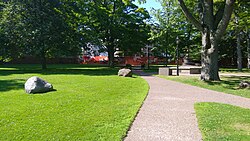| Charlottetown Boulder Park | |
|---|---|
 | |
 | |
| Type | Boulder Park |
| Location | Charlottetown, Prince Edward Island |
| Coordinates | 46°14′08″N63°07′33″W / 46.2355°N 63.12587°W |
| Opened | 1966 |
| Founder | Dr. Eric Harvie |
| Operated by | Confederation Centre of the Arts |
| Open | All year |
Charlottetown Boulder Park is an outdoor boulder park located in Charlottetown, Prince Edward Island. The park is located on the northern side of the Honourable George Coles Building, adjacent to Province House. [1]






















